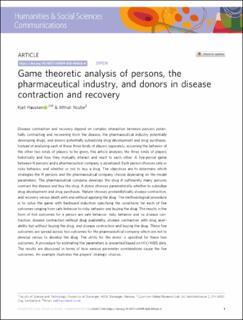| dc.contributor.author | Hausken, Kjell | |
| dc.contributor.author | Ncube, Mthuli | |
| dc.date.accessioned | 2020-11-23T12:43:00Z | |
| dc.date.available | 2020-11-23T12:43:00Z | |
| dc.date.created | 2020-10-08T20:18:41Z | |
| dc.date.issued | 2020 | |
| dc.identifier.citation | Hausken, K., Ncube, M. (2020) Game Theoretic Analysis of Persons, the Pharmaceutical Industry, and Donors in Disease Contraction and Recovery. Humanities & Social Sciences Communications, 7. | en_US |
| dc.identifier.issn | 2662-9992 | |
| dc.identifier.uri | https://hdl.handle.net/11250/2689123 | |
| dc.description.abstract | Disease contraction and recovery depend on complex interaction between persons potentially contracting and recovering from the disease, the pharmaceutical industry potentially developing drugs, and donors potentially subsidizing drug development and drug purchases. Instead of analyzing each of these three kinds of players separately, assuming the behavior of the other two kinds of players to be given, this article analyzes the three kinds of players holistically and how they mutually interact and react to each other. A five-period game between N persons and a pharmaceutical company is developed. Each person chooses safe or risky behavior, and whether or not to buy a drug. The objectives are to determine which strategies the N persons and the pharmaceutical company choose depending on the model parameters. The pharmaceutical company develops the drug if sufficiently many persons contract the disease and buy the drug. A donor chooses parametrically whether to subsidize drug development and drug purchases. Nature chooses probabilistically disease contraction, and recovery versus death with and without applying the drug. The methodological procedure is to solve the game with backward induction specifying the conditions for each of five outcomes ranging from safe behavior to risky behavior and buying the drug. The results in the form of five outcomes for a person are safe behavior, risky behavior and no disease contraction, disease contraction without drug availability, disease contraction with drug availability but without buying the drug, and disease contraction and buying the drug. These five outcomes are spread across two outcomes for the pharmaceutical company which are not to develop versus to develop the drug. The utility for the donor is specified for these two outcomes. A procedure for estimating the parameters is presented based on HIV/AIDS data. The results are discussed in terms of how various parameter combinations cause the five outcomes. An example illustrates the players’ strategic choices. | en_US |
| dc.language.iso | eng | en_US |
| dc.publisher | Springer Nature | en_US |
| dc.rights | Navngivelse 4.0 Internasjonal | * |
| dc.rights.uri | http://creativecommons.org/licenses/by/4.0/deed.no | * |
| dc.subject | game theory | en_US |
| dc.title | Game Theoretic Analysis of Persons, the Pharmaceutical Industry, and Donors in Disease Contraction and Recovery | en_US |
| dc.type | Peer reviewed | en_US |
| dc.type | Journal article | en_US |
| dc.description.version | publishedVersion | en_US |
| dc.rights.holder | © The Author(s) 2020 | en_US |
| dc.subject.nsi | VDP::Samfunnsvitenskap: 200 | en_US |
| dc.source.pagenumber | 17 | en_US |
| dc.source.volume | 7 | en_US |
| dc.source.journal | Humanities & Social Sciences Communications | en_US |
| dc.identifier.doi | 10.1057/s41599-020-00626-4 | |
| dc.identifier.cristin | 1838325 | |
| dc.source.articlenumber | 150 | en_US |
| cristin.ispublished | true | |
| cristin.fulltext | original | |
| cristin.qualitycode | 1 | |

